Lida Group Sets a New Industry Standard for Durability with Its High-Quality Steel Structure Warehouse Designs.
2025-Aug-26 10:06:38
By Admin
1. Introduction
In the global landscape of logistics and industrial infrastructure, the demand for reliable, long-lasting warehouse facilities has never been higher. As businesses expand their operations across borders and e-commerce continues to surge, the need for storage spaces that can withstand diverse environmental conditions, heavy operational loads, and the test of time has become a critical priority. Among the various construction materials used in warehouse development, steel has emerged as a preferred choice due to its inherent strength, flexibility, and cost-effectiveness. However, not all steel structure warehouses are created equal. Many existing facilities fall short in terms of durability, often succumbing to corrosion, structural fatigue, or damage from extreme weather events within a relatively short lifespan. This gap in the market has created an opportunity for industry leaders to redefine the standards of quality and durability.
Lida Group, a prominent player in the global construction and engineering sector, has stepped up to this challenge. With years of expertise in steel structure design and manufacturing, the company has dedicated its resources to developing high-quality steel structure warehouse solutions that set a new benchmark for durability in the industry. Unlike conventional warehouse designs that prioritize short-term cost savings over long-term performance, Lida Group’s approach focuses on integrating advanced materials, innovative engineering techniques, and rigorous quality control measures to ensure that its warehouses not only meet but exceed the expectations of clients in terms of lifespan, resilience, and operational efficiency. This article will delve into the various aspects of Lida Group’s steel structure warehouse designs, exploring how the company’s innovations are revolutionizing the industry and establishing a new standard for durability.
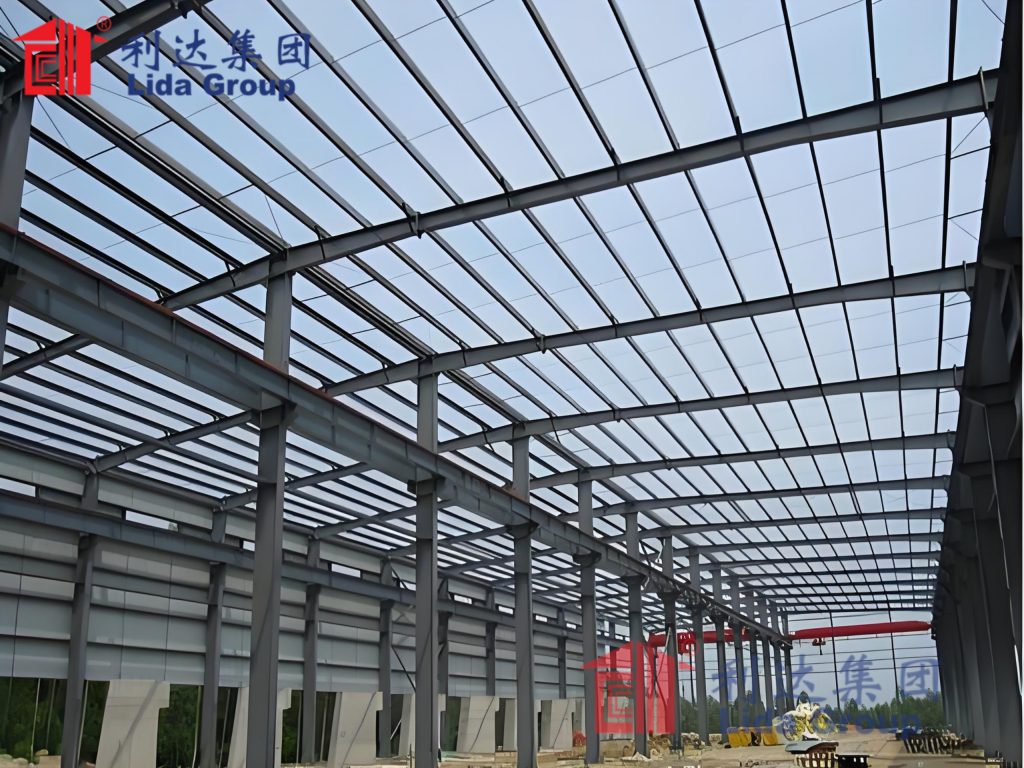
2. The Significance of Durability in Steel Structure Warehouses
Before delving into Lida Group’s specific contributions, it is essential to understand why durability is such a crucial factor in steel structure warehouse design. Warehouses serve as the backbone of supply chain operations, housing valuable inventory, machinery, and equipment. A durable warehouse ensures that these assets are protected from external threats such as harsh weather, pests, and structural failures, minimizing the risk of financial losses for businesses. Additionally, a long-lasting warehouse reduces the need for frequent repairs and renovations, which can be disruptive to operations and incur significant costs over time.
In regions prone to extreme weather conditions, such as high winds, heavy snowfall, earthquakes, or coastal areas with high humidity and salt exposure, durability becomes even more critical. Conventional steel warehouses often struggle in these environments. For example, steel components that are not properly protected against corrosion can start to rust within a few years, weakening the structure and compromising its safety. Similarly, warehouses with inadequate structural support may fail to withstand heavy snow loads or strong winds, leading to collapses or extensive damage.
Moreover, in an era where sustainability is a key concern for businesses and governments worldwide, durability plays a vital role in reducing the environmental impact of construction. A warehouse with a longer lifespan requires fewer resources for replacement, reducing carbon emissions associated with manufacturing new materials and constructing new facilities. It also minimizes waste generated from demolition and disposal of old structures. Therefore, improving the durability of steel structure warehouses is not only beneficial for businesses but also aligns with global efforts to promote sustainable development.

3. Lida Group’s Approach to Durability: Materials Selection
At the core of Lida Group’s high-quality steel structure warehouse designs is its meticulous approach to materials selection. The company recognizes that the durability of a steel structure begins with the quality of the steel itself, and thus, it sources only the highest-grade steel from reputable suppliers. Unlike some competitors that use lower-grade steel to cut costs, Lida Group prioritizes steel grades that offer superior strength, corrosion resistance, and fatigue performance.
One of the key steel grades used by Lida Group is S355JR, a structural steel that is widely recognized for its excellent mechanical properties. S355JR steel has a minimum yield strength of 355 MPa, making it highly resistant to deformation under heavy loads. It also exhibits good ductility, which allows it to absorb energy during extreme events such as earthquakes, reducing the risk of sudden structural failure. In addition to S355JR, Lida Group also uses S460NL steel for certain critical components. S460NL is a low-alloy high-strength steel that offers even higher yield strength (460 MPa) and excellent toughness, making it ideal for use in warehouses located in seismic zones or areas with harsh weather conditions.
To further enhance the corrosion resistance of its steel components, Lida Group employs advanced surface treatment technologies. One of the most effective methods used by the company is hot-dip galvanizing. In this process, steel components are submerged in a bath of molten zinc, which forms a thick, adherent zinc coating on the surface. This coating acts as a barrier against moisture, oxygen, and other corrosive elements, preventing rust from forming. Unlike paint or other organic coatings that can chip or peel over time, hot-dip galvanizing provides long-lasting protection, with a lifespan of up to 50 years in rural environments and 20-30 years in coastal or industrial areas.
In addition to hot-dip galvanizing, Lida Group also offers polyester powder coating as an optional surface treatment. Polyester powder coating provides a decorative and protective finish that is resistant to fading, chipping, and chemical damage. This coating is particularly popular among clients who require warehouses with a specific aesthetic appearance, such as those located in commercial or residential areas. By combining hot-dip galvanizing with polyester powder coating, Lida Group ensures that its steel components offer both exceptional corrosion resistance and an attractive finish.

4. Innovative Structural Design: Enhancing Strength and Resilience
While high-quality materials are essential, Lida Group understands that even the best materials can underperform if not supported by a well-designed structure. Therefore, the company invests heavily in innovative structural design to maximize the strength, resilience, and durability of its steel structure warehouses.
One of the key design innovations introduced by Lida Group is the optimized frame structure. Traditional steel warehouse frames often use a simple beam-column design, which can be prone to bending and deflection under heavy loads. Lida Group’s engineers, however, have developed a frame structure that incorporates rigid connections and moment-resisting frames to distribute loads more evenly across the structure. Rigid connections ensure that the beams and columns act as a single unit, reducing the risk of localized stress concentrations that can lead to structural fatigue. Moment-resisting frames, on the other hand, are designed to resist rotational forces, making the structure more stable during earthquakes or high winds.
Another important aspect of Lida Group’s structural design is the use of trusses for roof and wall systems. Trusses are lightweight yet strong structural elements that consist of a series of triangular units. This design allows trusses to span large distances without the need for intermediate supports, creating more open and flexible warehouse spaces. Moreover, the triangular shape of trusses provides excellent load-bearing capacity, enabling them to withstand heavy snow loads, wind loads, and even the weight of heavy equipment such as cranes or HVAC systems installed on the roof. Lida Group’s engineers carefully design each truss based on the specific environmental conditions and operational requirements of the warehouse, ensuring that it is optimized for maximum strength and durability.
In addition to the frame and truss systems, Lida Group also pays close attention to the foundation design of its warehouses. The foundation is the base of any structure, and a weak or poorly designed foundation can compromise the entire warehouse’s durability. Lida Group conducts detailed site investigations before starting any project to assess the soil conditions, groundwater levels, and seismic activity of the area. Based on these findings, the company designs foundations that are tailored to the specific site conditions. For example, in areas with soft soil, Lida Group uses pile foundations to transfer the weight of the warehouse to deeper, more stable soil layers. In seismic zones, the company incorporates seismic isolation devices into the foundation design to reduce the impact of earthquake vibrations on the structure.
To ensure that its structural designs meet the highest standards of safety and durability, Lida Group uses advanced computer-aided design (CAD) and finite element analysis (FEA) software. These tools allow engineers to simulate various load conditions, including static loads (such as the weight of inventory and equipment), dynamic loads (such as wind and earthquake forces), and environmental loads (such as temperature changes and moisture). By conducting these simulations, engineers can identify potential weak points in the design and make necessary adjustments before construction begins. This proactive approach not only ensures that the warehouse is durable but also helps to reduce the risk of costly design errors during construction.
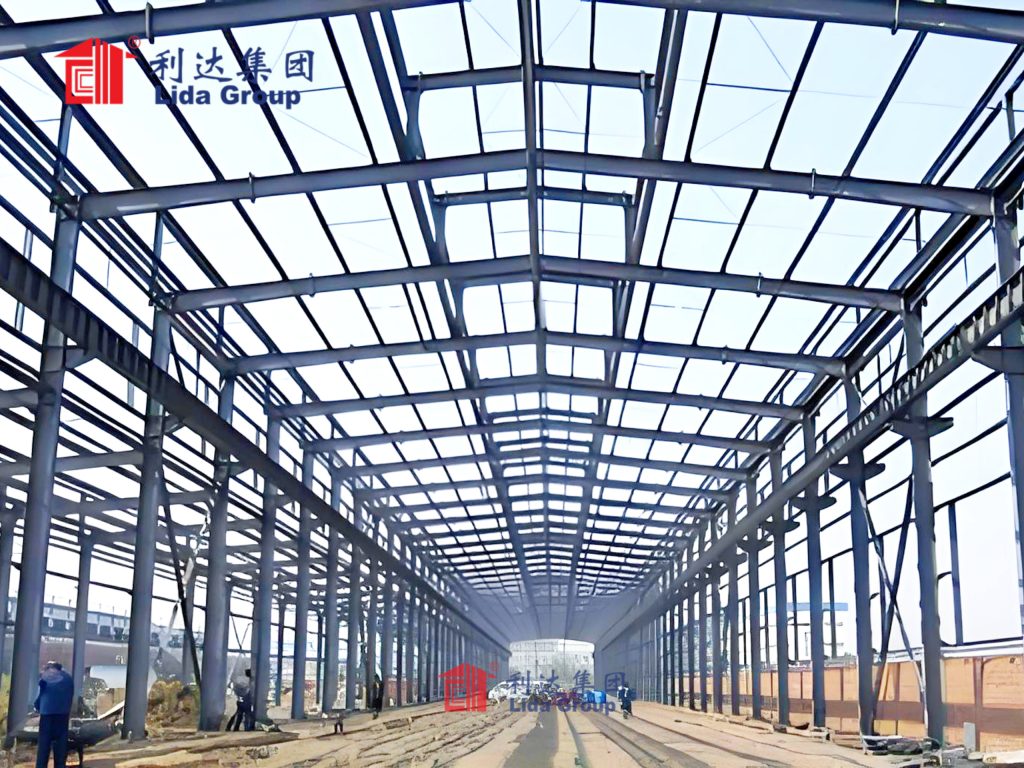
5. Advanced Manufacturing and Construction Processes
In addition to materials selection and structural design, Lida Group’s commitment to durability extends to its manufacturing and construction processes. The company operates state-of-the-art manufacturing facilities equipped with advanced machinery and technology, ensuring that its steel components are produced with precision and consistency.
One of the key manufacturing processes used by Lida Group is CNC (Computer Numerical Control) cutting and drilling. CNC machines use computer programs to control the cutting and drilling of steel plates and sections, ensuring that each component is produced to exact specifications. This level of precision is crucial for ensuring that the components fit together seamlessly during construction, reducing the need for on-site modifications that can compromise the structure’s integrity. Moreover, CNC cutting and drilling minimize material waste, making the manufacturing process more efficient and sustainable.
After the steel components are cut and drilled, they undergo a series of quality inspections to ensure that they meet Lida Group’s strict standards. These inspections include dimensional checks, visual inspections for defects such as cracks or bends, and mechanical property tests to verify the strength and toughness of the steel. Any components that fail to meet the standards are rejected and sent back for rework or replacement. This rigorous quality control process ensures that only the highest-quality components are used in the construction of Lida Group’s warehouses.
Once the components are manufactured and inspected, they are transported to the construction site for assembly. Lida Group uses a prefabricated construction method, which involves assembling the steel components in a factory before transporting them to the site. This method offers several advantages over traditional on-site construction. First, prefabrication allows for greater control over the quality of the assembly, as the components are assembled in a controlled environment free from weather-related disruptions. Second, prefabrication reduces the construction time on-site, minimizing the impact on the surrounding area and allowing the warehouse to be operational sooner. Third, prefabrication reduces the amount of waste generated on-site, making the construction process more sustainable.
During the on-site assembly process, Lida Group’s construction team follows a detailed construction plan developed by the engineering team. The team uses advanced lifting equipment and tools to ensure that the components are installed safely and accurately. Each connection is carefully inspected to ensure that it is tight and secure, and any necessary adjustments are made immediately. After the steel structure is assembled, the team installs the roof, walls, and other components, such as doors and windows, to complete the warehouse.
To further enhance the durability of the warehouse, Lida Group also pays attention to the details of the construction process. For example, the company ensures that all gaps between steel components are properly sealed to prevent water infiltration, which can lead to corrosion. The company also uses high-quality fasteners, such as bolts and nuts, that are resistant to corrosion and loosening. These small but important details play a significant role in ensuring the long-term durability of the warehouse.
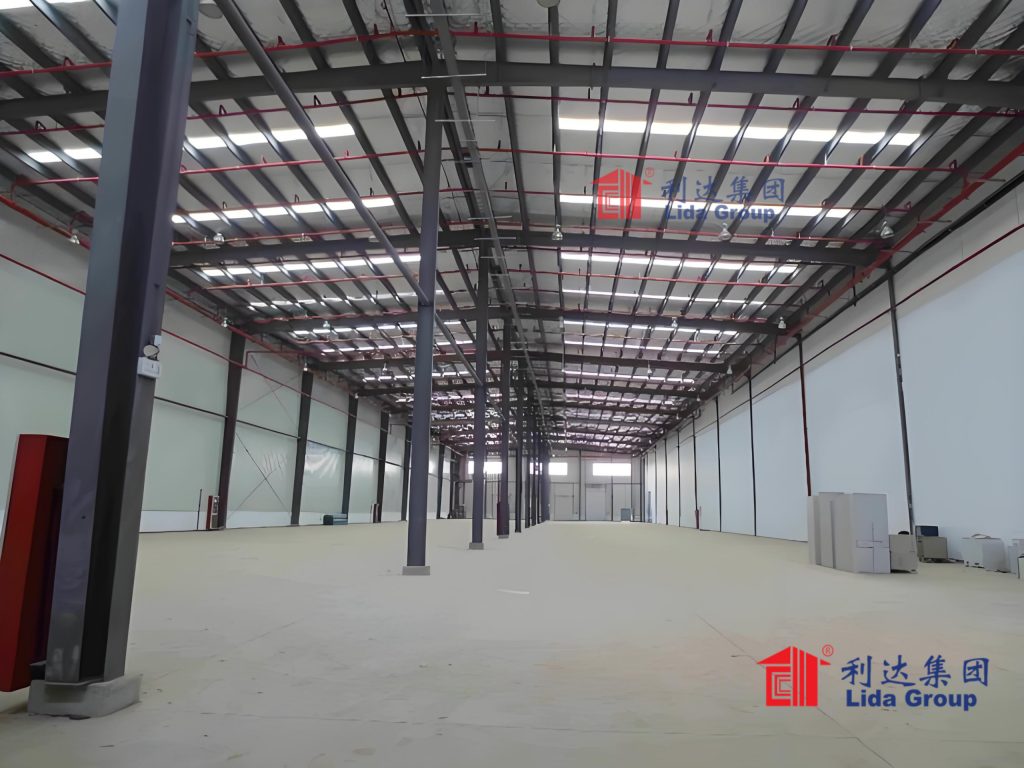
6. Case Studies: Lida Group’s Durable Steel Structure Warehouses in Action
To illustrate the effectiveness of its high-quality steel structure warehouse designs, let’s examine some real-world case studies of Lida Group’s projects. These case studies demonstrate how the company’s warehouses have performed in various environmental conditions and operational scenarios, highlighting their durability and reliability.
6.1 Case Study 1: Industrial Warehouse in a Seismic Zone (Japan)
Japan is one of the most seismically active countries in the world, making it a challenging environment for warehouse construction. A leading automotive parts manufacturer in Japan approached Lida Group to design and build a 10,000-square-meter warehouse to store its inventory of automotive components. The client required a warehouse that could withstand earthquakes of magnitude 7.0 or higher and have a lifespan of at least 30 years.
Lida Group’s engineering team conducted a detailed site investigation to assess the seismic activity and soil conditions of the site. Based on the findings, the team designed a warehouse with a moment-resisting frame structure and pile foundations. The frame structure was made using S460NL steel, which offers high strength and toughness, while the pile foundations were driven to a depth of 20 meters to reach stable soil layers. The steel components were hot-dip galvanized to protect against corrosion, and the roof was designed with a steep slope to allow for the quick drainage of rainwater and snow.
The warehouse was completed in 2018, and since then, it has withstood several minor earthquakes and a major earthquake of magnitude 6.5 in 2021. Despite the strong tremors, the warehouse suffered no structural damage, and the inventory inside remained intact. The client has reported that the warehouse requires minimal maintenance, with only routine inspections and cleaning needed. This case study demonstrates Lida Group’s ability to design warehouses that can withstand extreme seismic conditions while maintaining their durability and functionality.
6.2 Case Study 2: Coastal Warehouse in Southeast Asia (Malaysia)
Coastal areas in Southeast Asia are characterized by high humidity, salt-laden air, and frequent heavy rain, which can cause rapid corrosion of steel structures. A logistics company in Malaysia needed a 15,000-square-meter warehouse located near the port of Penang to store imported goods. The client was concerned about the potential for corrosion and required a warehouse that could resist the harsh coastal environment for at least 25 years.
Lida Group’s solution involved using a combination of hot-dip galvanizing and polyester powder coating for the steel components. The hot-dip galvanizing provided a base layer of corrosion protection, while the polyester powder coating added an additional barrier against salt and moisture. The warehouse’s roof was designed with a corrosion-resistant metal sheet, and the walls were insulated to prevent condensation, which can accelerate corrosion. The foundation was elevated to prevent flooding during high tides, and the drainage system was optimized to quickly remove rainwater.
The warehouse was commissioned in 2019, and after four years of operation, there is no visible signs of corrosion on the steel components. The client has noted that the warehouse remains in excellent condition, with no need for major repairs or repainting. The warehouse’s durability has allowed the logistics company to operate efficiently, even during the monsoon season, ensuring that goods are stored safely and securely.
6.3 Case Study 3: Cold Storage Warehouse in Northern Europe (Germany)
Cold storage warehouses present unique challenges for durability, as the constant temperature fluctuations between the inside (often below freezing) and the outside (which can be warm in summer) can cause condensation and frost damage to the structure. A food processing company in Germany needed a 8,000-square-meter cold storage warehouse to store frozen food products. The client required a warehouse that could maintain a constant temperature of -20°C and have a lifespan of at least 30 years.
Lida Group’s design focused on preventing condensation and frost damage. The steel structure was insulated with high-quality thermal insulation materials, and a vapor barrier was installed to prevent moisture from entering the structure. The steel components were treated with a special anti-corrosion coating that is resistant to low temperatures, and the floor was designed with a heated system to prevent freezing. The warehouse’s doors were equipped with airtight seals to maintain the internal temperature and prevent warm air from entering.
Since its completion in 2020, the cold storage warehouse has operated continuously, maintaining a stable temperature of -20°C. There have been no issues with condensation, frost damage, or corrosion of the steel structure. The client has been impressed with the warehouse’s durability and energy efficiency, noting that it has helped to reduce operating costs by minimizing heat loss.
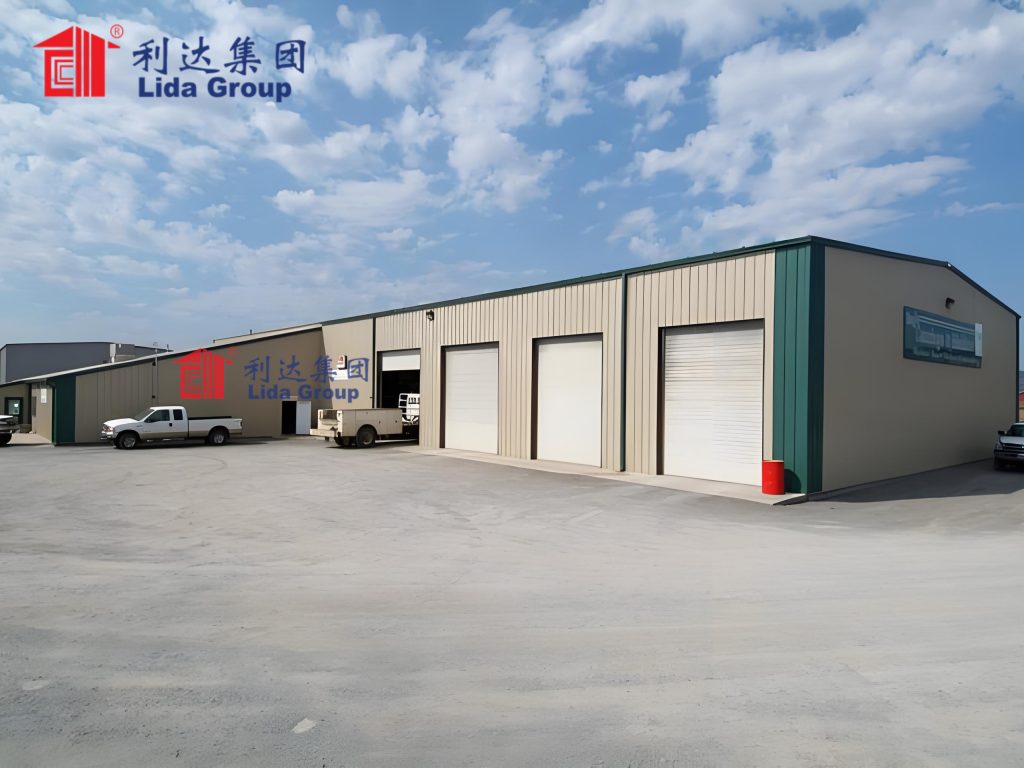
7. Industry Recognition and Certifications
Lida Group’s commitment to quality and durability has not gone unnoticed by the industry. The company has received numerous certifications and awards that validate its high standards of design, manufacturing, and construction.
One of the most prestigious certifications obtained by Lida Group is the ISO 9001 Quality Management System Certification. This certification recognizes the company’s ability to consistently provide products and services that meet customer and regulatory requirements. Lida Group’s quality management system covers all aspects of its operations, from materials sourcing and design to manufacturing and construction, ensuring that every warehouse meets the same high standards of quality.
In addition to ISO 9001, Lida Group has also obtained the ISO 14001 Environmental Management System Certification, which demonstrates its commitment to sustainable development. The company’s manufacturing and construction processes are designed to minimize environmental impact, from reducing material waste to using eco-friendly coatings and insulation materials.
Lida Group’s steel structure warehouses have also been certified by various international organizations, such as the CE Certification (for products sold in the European Union) and the AWS D1.1 Structural Welding Code (for welding quality). These certifications ensure that the company’s warehouses meet the strict safety and performance standards of different regions and markets.
The company has also received several industry awards for its innovative designs and durable solutions. For example, in 2022, Lida Group won the Global Steel Structure Design Award for its seismic-resistant warehouse design in Japan. In 2023, the company was recognized with the Sustainable Construction Award for its coastal warehouse in Malaysia, which was praised for its eco-friendly design and long-term durability.
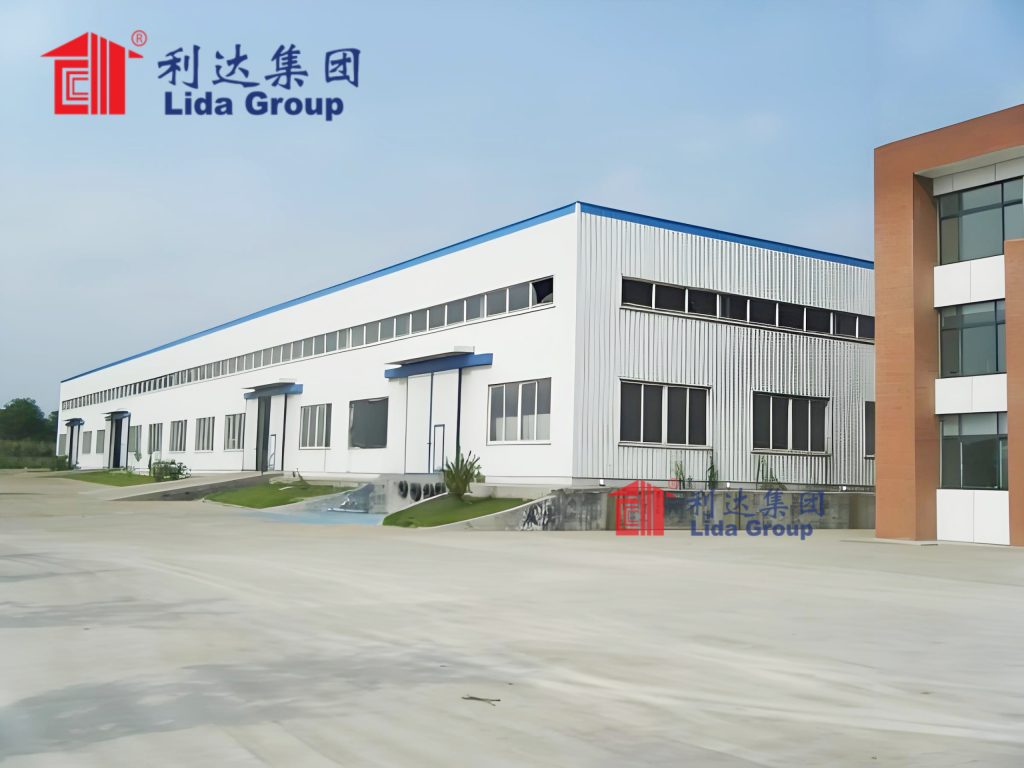
8. The Future of Durability in Steel Structure Warehouses
As the demand for durable warehouse facilities continues to grow, Lida Group is committed to staying at the forefront of innovation. The company’s research and development (R&D) team is constantly exploring new materials, technologies, and design approaches to further enhance the durability of its steel structure warehouses.
One area of focus for Lida Group’s R&D team is the development of high-performance steel alloys that offer even greater strength and corrosion resistance. The team is collaborating with leading steel manufacturers to test new alloys that can withstand extreme temperatures, high levels of salt, and other harsh environmental conditions. These new alloys could potentially extend the lifespan of steel structure warehouses to 50 years or more, further reducing the need for replacement and renovation.
Another area of innovation is the integration of smart technologies into warehouse design. Lida Group is exploring the use of sensors and monitoring systems that can detect early signs of corrosion, structural fatigue, or other issues. These systems would allow clients to monitor the condition of their warehouses in real-time and take proactive measures to address any problems before they become serious. For example, corrosion sensors could alert the client to the presence of moisture or salt in the air, allowing them to take steps to protect the steel components.
Lida Group is also investigating the use of sustainable materials in its warehouse designs. The company is exploring the use of recycled steel, which has the same strength and durability as virgin steel but requires less energy to produce. Additionally, the company is looking into using bio-based coatings and insulation materials that are more environmentally friendly than traditional options. By incorporating these sustainable materials, Lida Group aims to reduce the environmental impact of its warehouses while maintaining their durability.
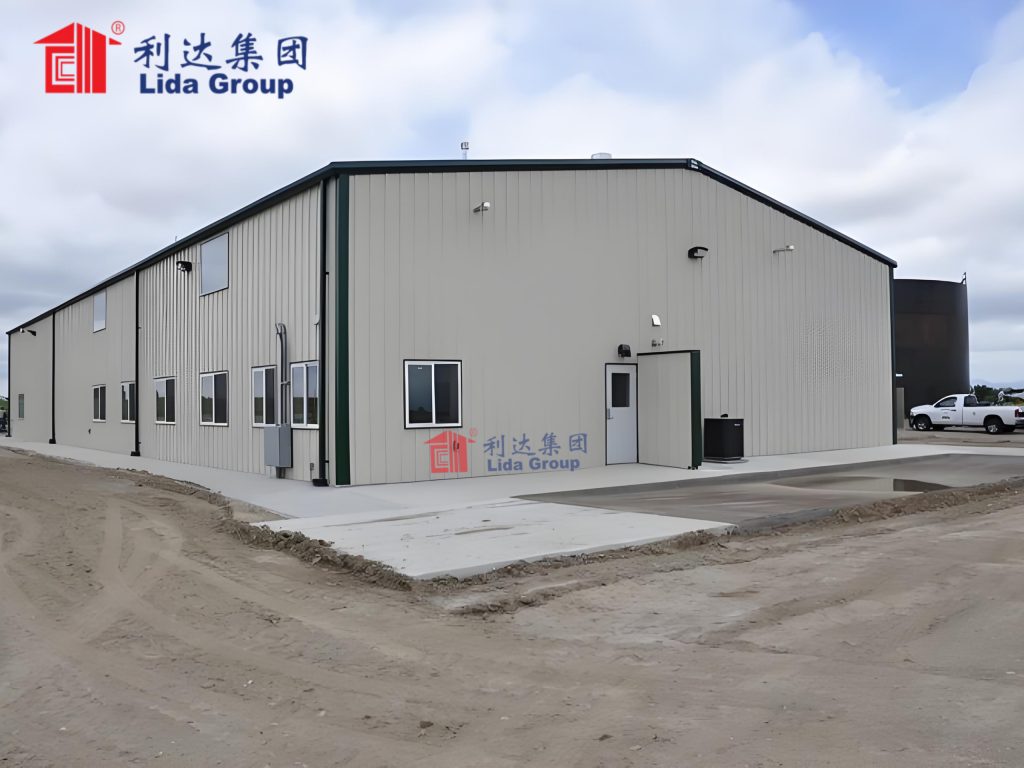
9. Conclusion
In conclusion, Lida Group has established itself as a leader in the design and construction of high-quality steel structure warehouses, setting a new industry standard for durability. Through its meticulous approach to materials selection, innovative structural design, advanced manufacturing and construction processes, and commitment to quality control, the company has developed warehouses that can withstand diverse environmental conditions, heavy operational loads, and the test of time.
The case studies highlighted in this article demonstrate the real-world effectiveness of Lida Group’s solutions, from seismic-resistant warehouses in Japan to corrosion-resistant facilities in coastal Malaysia and cold storage warehouses in Northern Europe. These projects have not only met the specific needs of clients but have also exceeded their expectations in terms of durability, reliability, and operational efficiency.
Lida Group’s industry recognition and certifications further validate its commitment to quality, ensuring that clients can trust the company’s warehouses to meet the highest standards of safety and performance. Looking to the future, the company’s ongoing investment in R&D and its focus on new materials, smart technologies, and sustainable practices will continue to drive innovation in the industry, further enhancing the durability of steel structure warehouses and contributing to a more sustainable and resilient built environment.
For businesses looking to invest in a warehouse that offers long-term value, reliability, and peace of mind, Lida Group’s high-quality steel structure warehouse designs are an excellent choice. By choosing Lida Group, clients can be confident that they are getting a facility that is built to last, providing them with a solid foundation for their operations for years to come.

Related news
-
Cost-Effective Expansion: Lida Group's Prefab Building Approach Cuts Temporary Sandwich House Construction Time and Budgets
2025-08-25 17:25:38
-
Arctic-Grade Innovation: Lida Group's Insulated Prefab Building Kits Deliver Warm High Quality Mobile Houses.
2025-08-25 16:59:27
-
Setting New Standards for Comfort: Lida Group's Prefab Building Methods Elevate Temporary Sandwich House Living.
2025-08-25 16:43:25
contact us
- Tel: +86-532-88966982
- Whatsapp: +86-13793209022
- E-mail: sales@lidajituan.com


